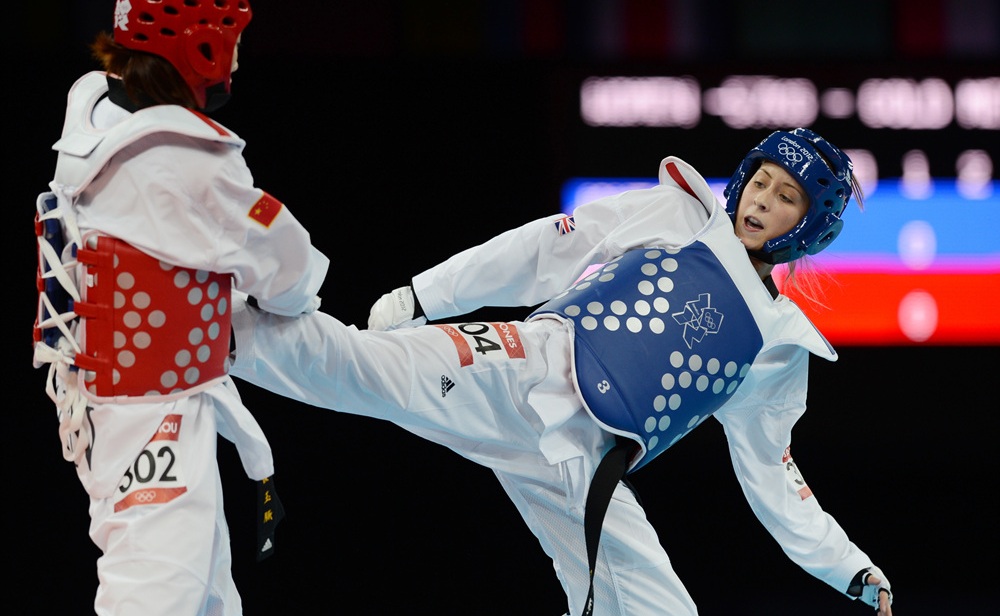(Aug 13, 2016) – From a potential three-time Olympic taekwondo gold medal winner to a dreadlocked competitor nicknamed after a carnivorous reptile, taekwondo’s fighting women promise to deliver a “Festival of Fight” at Rio 2016.
The 2016 Olympic taekwondo competition takes place over four days, from August 17 to August 20, at the Carioca Arena 3. One men’s and one women’s weight category, each containing 16 fighters, will be contested on each day. The four women’s weight categories are: -49kg, -57kg, -67kg and +67kg. How do these categories shape up?
-49kg: Can Wu Win Olympic Gold #3?
The biggest question hanging over this category – if not the biggest question hanging over the entire taekwondo tournament in Rio – is whether number-one ranked Chinese superstar Jingyu “Joy” Wu can be the first athlete ever to win three consecutive gold medals in Olympic taekwondo.
Wu seized golds in Beijing 2008 and London 2012, and after a layoff, utterly dominated her category in the 2015 Grand Prix series, winning a number of matches by 12-point difference. (Matches are halted if, after the first round, an athlete opens a 12-point gap over her opponent.) Cool-headed, Wu is a master at reading her opponent and controlling the fight, and wields a versatile arsenal of kicks.
She is nicknamed “Joy” – a translation of her Chinese name, but also a reflection of her sunny personality – which may explain why she was chosen as the WTF’s “Female Player of the Year” in 2015 by her peers. Remarkably, her Olympic heroics took place in fiction before they became fact. The then-unknown fighter played a bit part in the 2003 Chinese film “Taekwondo” about a fictional athlete who wins Olympic gold. Fast forward to Beijing 2008 and Wu was wearing real gold around her neck – a feat she repeated in London in 2012.
The number-two contender is Thailand’s Panipak Wongpattanakit. While she was dominated by Wu in 2015, she was the only fighter able to land a head kick on her. Taller and leggier than Wu, she will also have analyzed Wu’s game thoroughly. The number three contender is the highly experienced Croatian Lucija Zaninovic, who boasts excellent balance and flexibility. She will have some very special support from the stands: Her twin sister Ana is fighting in the -57 category. And Brazil’s fourth-seeded Iris Sing, fighting with a home-town advantage, is a force to be reckoned with.
Even so: All eyes are likely to be on Wu.
-57kg: The Great Rivalry
This category features perhaps the greatest rivalry in the game: That between the number-one ranked player, Great Britain’s Jade Jones, and the number-two ranked fighter, Spain’s Eva Calvo Gomez. In 2013, 2014 and 2015, the battles between these two lit up the fighting circuit. Jones, who took gold in London 2012, is known as “The Headhunter” for her game-winning high kick, and is ably coached by Paul Green, who has an unerring eye for calling successful video replays. Calvo Gomez is a master counter-kicker with sniper like-accuracy. Taller than Jones, she has the perfect physique for taekwondo: tall, lean and long-legged.
But neither the number one or number two seed is a dead cert for Rio gold. Number three-ranked Wahba Hedaya of Egypt beat both Jones and Calvo Gomez in the 2015 Grand Prix Series Final. With a “never-step-back” style, elastic legs and a distinctive white hijab, she is one of the most visually notable female taekwondo athletes. The number six seed, Japan’s Mayu Hamada is another serious challenger: She has beaten both the top girls and is the current world champion. Yet another dark horse in this category is Iran’s Kimia Alizadeh Zenoorin, who has defeated Jones twice.
So while the cognoscenti might like to see a classic final – Jones vs. Calvo Gomez – the likelihood of an upset in this division is strong.
-67kg: Can “The Abigator” Seize the Vacant Title?
With the winner of this category at London 2012, South Korea’s Kyungseon Hwang, no longer in contention, the title is vacant. The top-ranked fighter seeking to fill that vacancy is France’s Haby Niare.
The Parisian girl looked on-course for Rio throughout the 2015 fighting season, capping it with wins at the Grand Prix Series 3 and at the Grand Prix Series Final. She boasts superb flexibility and rhythm – she likes to dance in her spare time - and showcases an unorthodox style: One of her match-winning moves is the rare “scorpion kick” to the head, fired from close range. Known as “The Abigator” by her team mates – a wordplay on her name and the dangerous reptile - Niare loves to fight. With no French team in contention in the 2015 World Cup Team Championships, she fought on Team Mexico simply for the joy of it. And with her flowing dreadlocks and easy grin, “The Abigator” is a joy to watch both on and off the mats.
However, she is facing stiff competition. The number-two seed, Sweden’s Elin Johansson, is noted for her powerful head attacks and won bronze in London 2012 (albeit at a heavier category: She has moved down a weight). When she is on-form Johansson is a match for anyone, but admits that she has emotional ups and downs. The number-three seed, Chinese Taipei’s Chia-chia Chuang is another highly experienced player and current world champion; while the London 2012 silver medalist, Turkey’s Nur Tatar, brings plenty of know-how to the field of play.
One dark horse is up-and-coming Hyeri Oh, a strong medal favorite in South Korea. She won the 2015 World Taekwondo Championships at -73kg, and although she has had to shed weight for the Olympic -67kg category, she is one of the bigger and stronger fighters in this division armed with the diverse arsenal and best-of-breed coaching expected from Korean fighters.
+67kg: Long Legs vs. Long Experience
The women’s heavyweight category features perhaps the most diverse group of female fighters in the sport. With their varying physiques and styles, it is almost impossible to predict a winner.
The top-seeded fighter is Mexico’s Maria del Rosario Espinoza. A superstar in Mexico, Espinoza won gold in Bejing in 2008 and bronze in London 2012. A fierce proponent of power-based “old school” taekwondo, she is noted for her hammering punch – she has been dubbed “Mexico’s Fist of Fury” – and her spinning back kick. However, she is shorter than many other fighters in this category, which means her footwork will have to be spot on if she is to win a medal in Rio.
The number two fighter in the category, China’s Shuyin Zheng, towers over Espinoza. A proponent of “new school” taekwondo, she fights a stand-off game, picking up points with a versatile front-leg attack to the torso. However, her arsenal also includes the higher-scoring spinning back kick to the torso and ax kick to the head. A silver medalist at the 2015 World Taekwondo Championships, she has been steadily improving, winning the 2015 Grand Prix Series Final. The tall Chinese looks poised for glory in Rio.
The number-three ranked player is Great Britain’s Bianca Queen Bee” Walkden. Having been plagued by injuries in 2014 she made a scorching comeback in 2015, winning the World Championships and consistent medals in the Grand Prix series. Tall, leggy and leonine, the Liverpudlian operates successfully under pressure – she came from behind at the 2015 World Championships to beat France’s Gwladys Epangue in the dying seconds with an arcing kick to the head - but has lost three out of four fights to Zheng.
The London 2012 gold medalist is Serbia’s Milica Mandic. One of the sunniest and most popular personalities in the sport, Mandic, however, suffered a slump in 2015, and although she took bronze in the Grand Prix Series 3, the defending champion is only seeded in sixth place. The category also features two of the most experienced players in the sport, the Netherlands’ Reshmie Oogink, and France’s Epangue, who won bronze in Beijing 2008.
This diverse range of fighters makes the +67kg division perhaps the most interesting of taekwondo’s women’s weight categories.



































